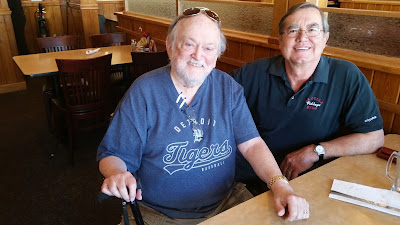 |
| Dr. Paul McGlynn and I--February 2016. |
Last week, I flew to Florida to visit my former English professor from Eastern Michigan University--Dr. Paul McGlynn. He earned his doctorate degree at Rice University in Texas and taught at Eastern Michigan for thirty-seven years, including the years during the Washtenaw County sex-slayings in the late 1960s.
We hadn't seen one another for forty years, but I knew Paul McGlynn had attended every court session of the John Norman Collins' trial and taken notes of the proceedings. His goal was to write a novel loosely based on the Collins' trial.
Author Edward Keyes was fresh off his success with the novel and movie The French Connection. As part of a multi-book contract, Keyes learned of the Collins' trial and the unsolved murders. He contracted with Simon and Schuster to write The Michigan Murders.
McGlynn read about Keyes' project in the Ann Arbor News, contacted him, and offered to help research his book. For an undisclosed stipend, McGlynn gave Keyes access to his trial notes. Much of what Keyes wrote regarding the trial comes directly from McGlynn's notes, and he gives McGlynn an acknowledgement in the introduction to The Michigan Murders.
Edward Keyes made an unfortunate editorial decision to use pseudonyms for the seven victims, their killer, and the witnesses. The overall effect was to obscure their identities and cloud the history behind these cases. Forty years later, people who lived through those times and were familiar with people involved with this case become confused after reading Keyes' novelization.
A debt is owed to history to get the facts straight. The Collins' trial was the longest and most expensive criminal proceeding in Washtenaw County history. After Collins' lawyers exhausted every appeal, the Supreme Court of the United States upheld the constitutionality of Collins' life sentence for first-degree murder. The high court returned the trial transcripts on April 19th, 1974. After that date, no mention of the transcripts is made in the county record log book.
After my researcher Ryan M. Place made an exhaustive statewide Freedom of Information search, the only response we received was from the Washtenaw County Clerk saying the records were "purged" in the mid-seventies. Why the county officials purged the trial transcripts is unknown. Surely, the historical significance of the case warrants that the public record be preserved somewhere--either in print or digitally.
Whether these documents were shredded for shelf space, misplaced through institutional neglect, or destroyed willfully to obfuscate the public record, the bottom line is they are missing. Meeting with Paul McGlynn was a unique opportunity to speak with someone who attended every court session. Collins is the only other person I know who was in court for all of the sessions, but he isn't talking.
My treatment of the trial is based on hundreds of vintage newspaper articles and interviews with some of the trial participants. The quoted dialogue from the daily reports is surprisingly detailed and helped me reconstruct the lost Collins' trial and the legal maneuvering that went on inside and outside the courtroom. Thank goodness for the press.
I asked Paul McGlynn if he would read my manuscript and question or comment on anything. I was most interested in his response to the trial. Here is what he wrote: "I'm wondering how you got the details of the trial so exactly. Did you finally manage to round up a transcript? It reads like a transcript, though of course much abbreviated. It brought back many memories of the long hours spent in the courtroom. Kudos."
 |
| East Cross Street/Depot Town/Water Tower |
Rather than dress-up this dark episode in Ypsilanti's history as narrative nonfiction, I decided to take a terse journalistic approach and retell the events as they happened. The facts and conflicts are enough to carry the story line without manufacturing melodrama.
With any luck, Terror in Ypsilanti: John Norman Collins Unmasked should be available in July 2016. I decided to change the title to make the book more suitable for internet searches.






